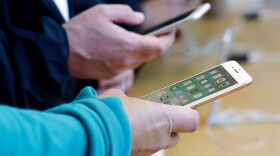On June 13, a man in New York began to feel ill.
"He starts to experience swollen lymph nodes and rectal discomfort," says epidemiologist Keletso Makofane, who's at Harvard University.
The man suspects he might have monkeypox. He's a scientist, and knowledgeable about the signs and symptoms, Makofane says. So the man goes to his doctor and asks for a monkeypox test. The doctor decides, instead, to test the man for common sexually transmitted diseases. All those come back negative.
"A few days later, the pain worsens," Makofane says. So he goes to the urgent care and again asks for a monkeypox test. This time, the provider prescribes him antibiotics for a bacterial infection.
"The pain becomes so bad, and starts to interfere with his sleep," Makofane says. "So this past Sunday, he goes to the emergency room of a big academic hospital in New York."
At this point the man has a growth inside his rectum, which is a symptom of monkeypox. At the hospital, he sees both an ER doctor and an infectious disease specialist. Again, the man asks for a monkeypox test. But the specialist rebuffs the request and says "a monkeypox test isn't indicated," Makofane says. Instead, the doctor speculates that the man might have colon cancer.
A few days later, he develops skin lesions — another key sign of monkeypox.
A misleading case count
On the surface, the monkeypox outbreak in the U.S. doesn't look that bad, especially compared with other countries. Since the international epidemic began in May, the U.S. has recorded 201 cases of monkeypox. In contrast, the U.K. has nearly 800 cases. Spain and Germany both have more than 500.
But in the U.S., the official case count is misleading, Makofane and other scientists tell NPR. The outbreak is bigger — perhaps much bigger — than the case count suggests.
For many of the confirmed cases, health officials don't know how the person caught the virus. Those infected haven't traveled or come into contact with another infected person. That means the virus is spreading in some communities and cities, cryptically.
"The fact that we can't reconstruct the transmission chain means that we are likely missing a lot of links in that chain," Jennifer Nuzzo, an epidemiologist at Brown University, says. "And that means that those infected people haven't had the opportunity to receive medicines to help them recover faster and not develop severe symptoms.
"But it also means that they're possibly spreading the virus without knowledge of the fact that they're infected," she adds.
In other words: "We have no concept of the scale of the monkeypox outbreak in the U.S.," says biologist Joseph Osmundson at New York University. "
Why are so few cases getting detected? Testing. In many ways, the U.S. has dropped the ball on monkeypox testing.
Across the nation, public health agencies are running too few tests — way too few, Osmundson says. "State officials are denying people testing because they're using a narrow definition of monkeypox to decide who receives a test. They're testing in only a very restrictive number of cases."
Take for instance the man Makofane knows. Eventually, after seeing more than four doctors, the man finally finds an activist who's trying to expand testing. The activist connects the man with a doctor who orders a test through a private company (that's working to produce a commercial test.) The result: He's positive. He has monkeypox.
Makofane says the testing situation right now is so "abysmal" in the U.S. that he launched his own study, called RESPND-MI, to figure out the prevalence of monkeypox in New York City and to help friends share information about monkepox.
The CDC would not divulge to NPR how many tests have been performed across the country, nor will the agency say where community transmission is likely occurring in the U.S. (NPR emailed the agency multiple times about these questions but the press person declined to comment or provide an interview.)
On Thursday, the CDC told the New York Times, it has performed 1,058 monkeypox tests. However, it's not clear how many of these tests are duplications for the same person. And several sources involved with monkeypox testing doubt the agency has tested that many cases. One source told NPR that, as of last Friday, the CDC had tested about 300 cases. At that time, about 100 of those tests were positive, giving a positivity rate of more than 30%.
When the outbreak first began last month, the CDC quickly helped to set up testing in about 70 state and local labs across the country. Unlike with COVID, the agency already had a test developed and ready to send to labs.
"We should celebrate that prior investment," Nuzzo says. "That's what preparedness means.
An ineffective testing system
But as the need for testing grew — and the disease became more common than officials initially predicted — the testing system set up by the CDC stopped functioning well, because it actually deters doctors from ordering a monkeypox test.
Providers have to go out of their way to order a test. They have to receive permission and instructions from local or state labs, Nuzzo says. The process is cumbersome and often time-consuming. Sometimes a doctor has to sit on the phone for hours.
"That's really the bottleneck that we're worried about," she says. "We need to cast a wider net with testing to find infections that we're missing. And that's really hard to do if we make it cumbersome and difficult for health care providers to request a test in the course of their busy days."
Nuzzo says the CDC and local health departments need to remove the barriers to testing. "I also want to make testing easier and more widespread so that all clinicians feel that they can test a patient. Any patient with a suspicious rash."
And doctors and nurses need to have a better understanding of what monkeypox actually looks like in patients. It's different from what's in medical textbooks. It can present like many other diseases, including herpes, syphilis and colon cancer.
"Infections have been largely found in men who have sex with men, who may typically seek care at a sexual health clinic," Nuzzo explains. "Those providers may be particularly well-educated now about monkeypox and may be more willing to send a specimen out for testing. But we may not be seeing that level of education and willingness to test with other health care providers, who see different kinds of patients. And that means we may be missing infections in different patient groups."
On Thursday afternoon, the CDC announced they were working to ramp up testing at the main labs that health providers normally use. And the agency is aiming to make testing easier sometime in July.
But Nuzzo says changes to testing need to happen right away. It needs to be easier, right now, for doctors to submit samples to the labs already doing this testing.
"Time is not on our side here," she says. "Every day we delay, we are missing links in the transmission chain and are allowing this outbreak to grow possibly beyond control."
And monkeypox, just like COVID, may become a long-term — perhaps even permanent — problem here in the U.S.
Copyright 2022 NPR. To see more, visit https://www.npr.org. 9(MDAzMjM2NDYzMDEyMzc1Njk5NjAxNzY3OQ001))








